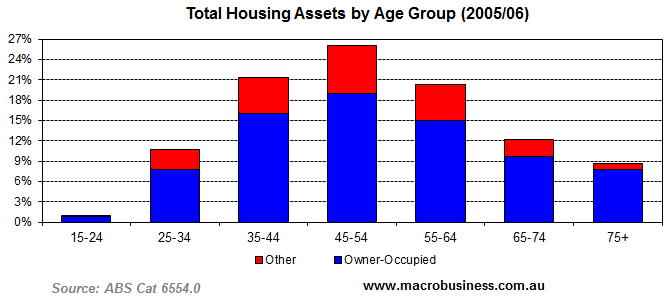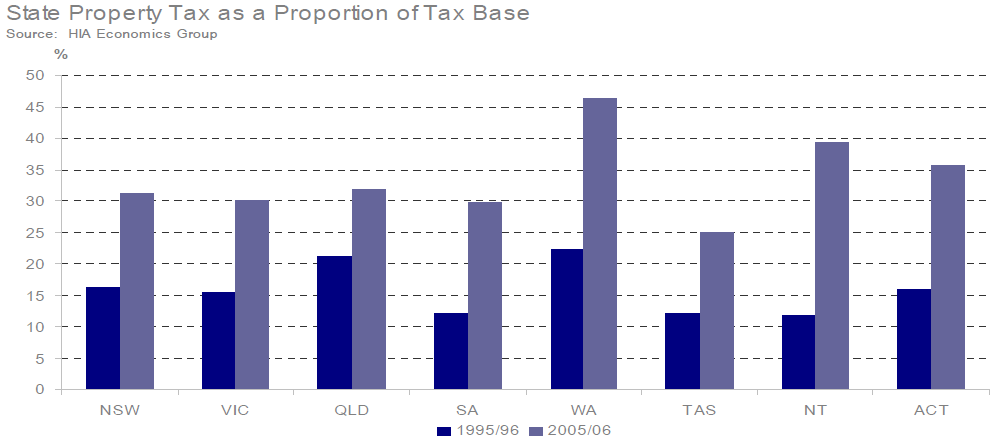The 21st century will be the century of old age, where declining birth rates meet longer life expectancies. This ageing of the population will affect many areas of the international economy, from consumption and growth to asset valuations.
The impacts from ageing will likely be most acute in Western Nations, although some developing countries, most notably China, will also be negatively affected.
Australia is not immune from these demographic headwinds. As shown by the below chart, for the past 25 years, Australia’s total dependency ratio – the ratio of the non-working population, both children and the elderly, to the working age population – has been in a demographic ‘sweet spot’. That is, there has been a high proportion of working age people supporting only a small pool of dependents. This ‘sweet spot’ has come about from two main factors:
- The Baby Boomer generation – defined by the Australian Bureau of Statistics (ABS) as those born between 1946 and 1965 and comprising around 25% of Australia’s population – has been at working age; and
- Declining birth rates from the mid-1970s.
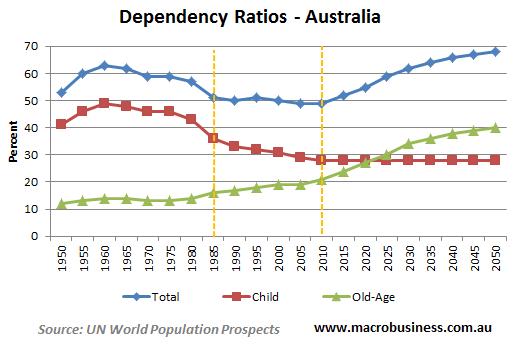
However, 2011 marks the year when the oldest members of the Baby Boomer generation – those born in 1946 – turns 65 and reaches official retirement age. Accordingly, Australia’s dependency ratio is projected to worsen progressively each year from now on as the Baby Boomers gradually enter retirement.
Australia’s demographics are similar to those of other Western nations, which have also experienced similar demographic ‘sweet spots’ as well as rising dependency ratios going forward (see below chart).
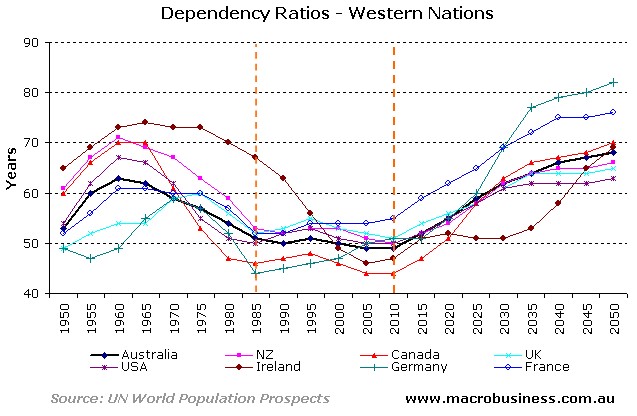
To put the number of retirees in Australia into perspective, consider the number of Australians turning 65 each week between 2000 and 2030:
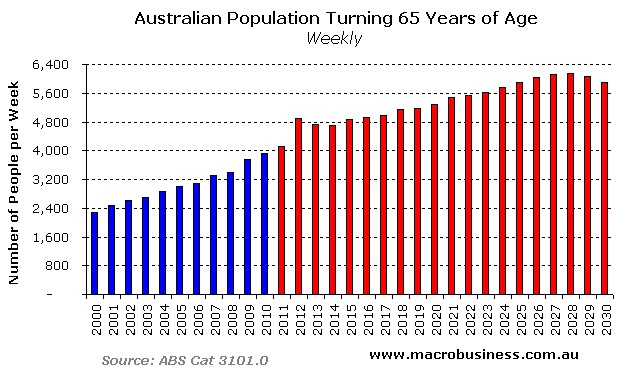
As you can see, the number of retirees has been on the rise since 2000. And this trend is expected to continue for another 15 years or so.
Accordingly, the proportion of Australia’s population aged 65 or above is projected to rise from around 14% currently to 24% in 2050. Similarly, Australia’s median age is expected to increase from around 38 years of age currently to 43 years in 2050 (see below chart).
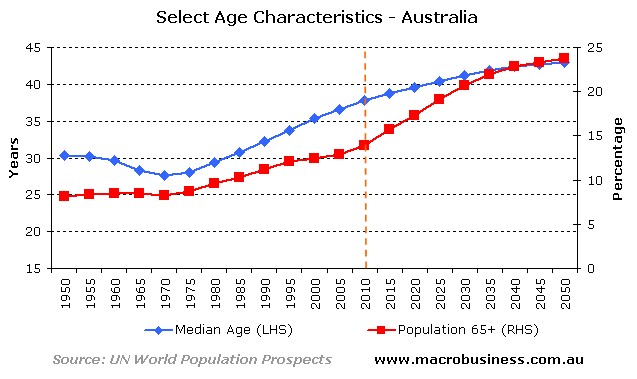
An increase in the dependency ratio will, other things equal, lower Australia’s growth potential via reduced expenditure, lower asset valuations, and higher rates of taxation. These impacts are summarised below.
Consumption expenditure:
First, consider the below chart showing how much household income falls once retirement is reached.
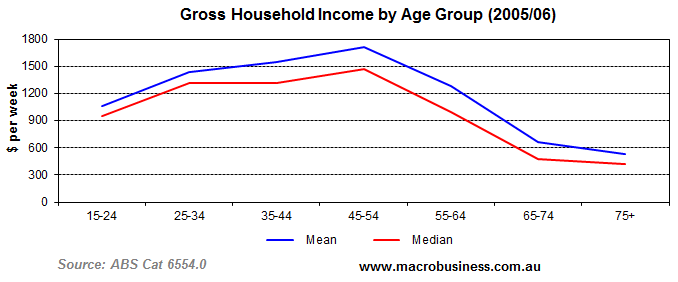
As you can see, household income peaks between the ages of 45 and 54, before dropping sharply. A household in retirement earns just over a third of what a 45 to 54 year old household earns.
A similar situation applies with respect to expenditure. Household spending peaks between the ages of 45 and 54, before falling sharply. A household in retirement spends less than half of what a 45 to 54 year-old household does (see below chart).
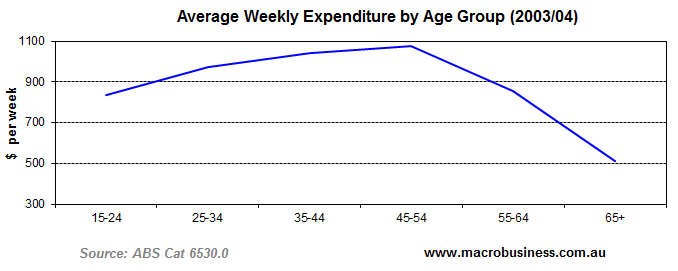
Asset values:
An earlier article, Baby Boomers, Retirement and Asset Prices, provides a comprehensive examination of the negative effects that ageing will likely have on Australian asset prices (particularly housing). Here are the key takeaways from that article:
- Despite representing only 25% of Australia’s population, the Baby Boomers collectively hold 45% of owner-occupied dwellings and 51% of other dwellings (i.e. investment properties and holiday homes). However, since the older Boomer cohort (55-64 year-olds) are relatively small (accounting for 11% of the population), they hold a smaller (20%) share of Australia’s housing assets. By contrast, the younger Boomers (45-54 year-olds) hold 26% of the housing assets, reflecting their larger (14%) share of the population (see below chart).
- Around 30% of Baby Boomers hold second homes and around 13% have loans over these properties (click to view table).
- When it comes to financial assets, the Baby Boomers hold 54% of the total (see below chart).
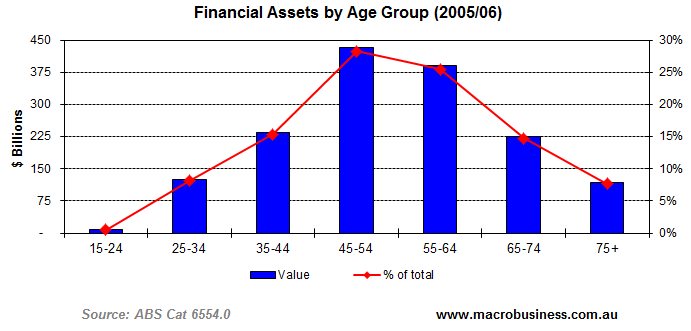
- Most Baby Boomers are heavily exposed to property and hold relatively little in the way of financial assets – certainly not enough to fund a comfortable retirement. It is, therefore, highly likely that many will look to sell their investment properties/holiday homes and/or downsize in order to free-up the equity in their housing assets to finance retirement. The incentive to sell-out of their properties will likely intensify once the Boomers realise that there is little prospect of continued high capital appreciation.
- A recent Bank for International Settlements (BIS) Working Paper found that the ageing of the Baby Boomers is projected to reduce Australia’s real house price growth by around 30% in real terms over the next 40 years compared to neutral demographics (see below chart). The BIS also expects ageing to have a similar impact on the value of financial assets.
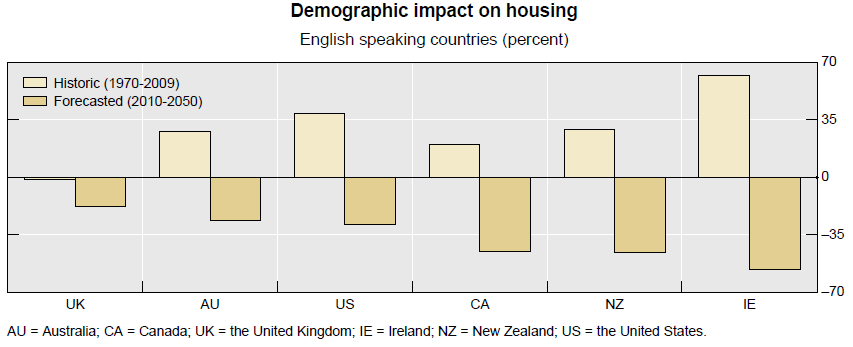
Again, readers seeking to gain a better understanding of the Baby Boomer retirement’s impact on asset prices are encouraged to read my earlier detailed examination.
Government revenue and taxation:
The 2010 Intergenerational Report (IGR) had the following to say about the impact of ageing on Government finances:
Population ageing will create pressure for increased spending, particularly in the demographically sensitive areas of age related programs and health. Health costs will also escalate as a result of technological enhancements and rising demand for better quality health services. Population ageing, by reducing the proportion of working age people in the population and hence potential economic growth rates, will also reduce Australia’s capacity to fund these spending pressures.
Unless action is taken to increase the growth potential of the economy and ensure spending is sustainable, spending will exceed revenue and result in a fiscal gap of 2¾ per cent of GDP by 2049–50.
However, the IGR possibly underestimated the fiscal impact of ageing, since it ignored the impact of declining property valuations on state government budgets. As shown by the below HIA chart, Australia’s state governments have become increasingly reliant on property taxes. And any decline in valuations brought about from the retirement of the Baby Boomers would clearly have a detrimental impact on state finances.
Demographic headwinds are the new normal:
For the past 30 years, the Australian economy has been powered by the Baby Boomers, whose entry into the workforce en masse in the 1980s saw Australia’s dependency ratio fall to all time lows. This demographic ‘sweet spot’, whereby Australia’s dependency ratio was at its lowest ever level, lasted for 25 years from 1985 to 2010. During this period, Australia’s economy benefited enormously from the Boomer’s productive capacity, consumption spending, and taxation receipts, which peaked after the 1990s as they reached peak earning/spending age (45 to 55 years of age).
Asset values, too, were pushed-up by the Baby Boomers as they accumulated vast amounts of housing and financial assets with the aim of funding their retirements.
From 2011 onwards, however, Australia’s economy will face significant demographic headwinds as the Baby Boomers gradually: enter retirement; cut back on spending; draw-down on assets; cease paying tax; and receive increasing levels of health care and social security, funded by increasing taxes on the younger generations.
These factors will likely significantly lower Australia’s growth potential and asset valuations going forward.
Cheers Leith

